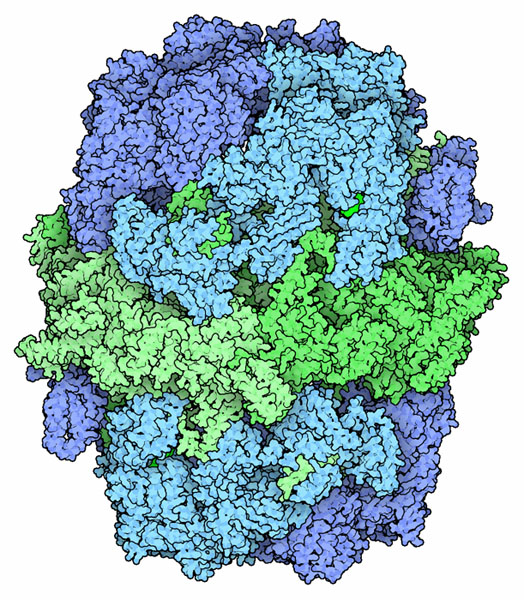|
Inhaltsübersicht | Nanomaschinen | Moleküle | Programme | Kurse | Fun | Links |
||
| > |
Fatty Acid Synthase

Fat, these days, is a bad word. But we can't survive without fats, and more particularly, without fatty acids. Fatty acids are small molecules composed of a long string of carbon and hydrogen atoms, with an acidic group at one end. They are used for two essential things in your body. First, they are used to build the lipids that make up all of the membranes around and inside your cells. Second, fatty acids are a concentrated source of energy, so they are often connected to glycerol to form fats, which is a compact way to store energy until it is needed. But as we all know, if we eat too much, this extra fat can build up!
Building Fats from Scratch
We get most of our fatty acids from our diet, but our cells also make enzymes that can construct most of our fatty acids, if needed. The construction of fatty acids is a stepwise process, adding carbon atoms two at a time to the growing chain. It takes four separate chemical reactions at each step, first adding the carbon atoms and then reducing them to the proper hydrocarbon form. It also takes several additional enzymes to start the process, and a few more to clip off the finished fatty acid at the end.
Fat Factory
Remarkably, in our cells all of these complicated tasks are performed by one long protein chain. It folds into a bunch of connected domains that each do different steps in the reaction. You can see a low resolution structure of our complicated fatty acid synthase in the PDB file 2cf2. The one shown here is from a fungus, from PDB entries 2uvb and 2uvc, which combines all of these functions in two chains. The entire complex has 12 chains total, six alpha chains the middle (in green here) and three beta chains at each end (in blue). All the action happens inside this big hollow ball. Inside, the growing fatty acid is attached to a flexible tether and it flips from site to site inside the enzyme as more and more carbon atoms are added.
Last changed by: A.Honegger,